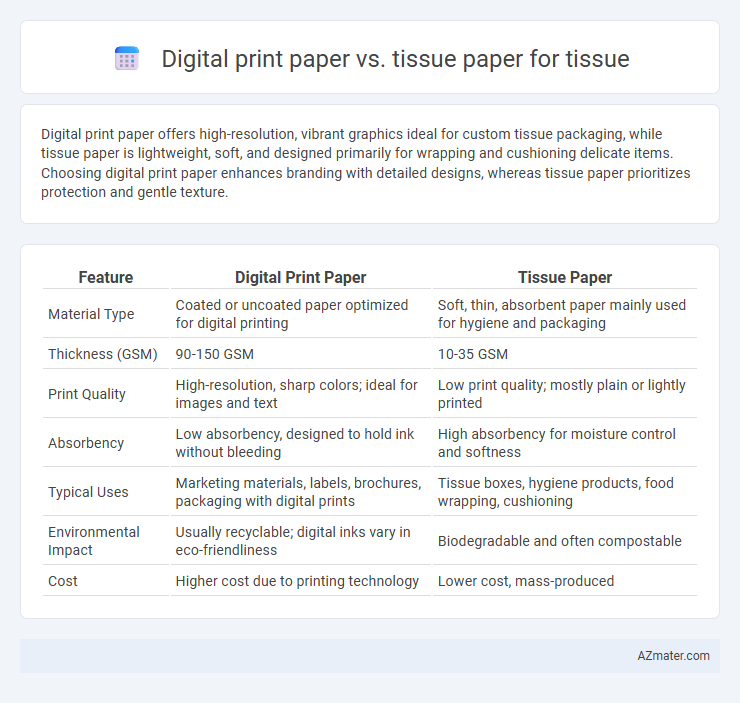Digital print paper offers high-resolution, vibrant graphics ideal for custom tissue packaging, while tissue paper is lightweight, soft, and designed primarily for wrapping and cushioning delicate items. Choosing digital print paper enhances branding with detailed designs, whereas tissue paper prioritizes protection and gentle texture.
Table of Comparison
| Feature | Digital Print Paper | Tissue Paper |
|---|---|---|
| Material Type | Coated or uncoated paper optimized for digital printing | Soft, thin, absorbent paper mainly used for hygiene and packaging |
| Thickness (GSM) | 90-150 GSM | 10-35 GSM |
| Print Quality | High-resolution, sharp colors; ideal for images and text | Low print quality; mostly plain or lightly printed |
| Absorbency | Low absorbency, designed to hold ink without bleeding | High absorbency for moisture control and softness |
| Typical Uses | Marketing materials, labels, brochures, packaging with digital prints | Tissue boxes, hygiene products, food wrapping, cushioning |
| Environmental Impact | Usually recyclable; digital inks vary in eco-friendliness | Biodegradable and often compostable |
| Cost | Higher cost due to printing technology | Lower cost, mass-produced |
Introduction to Digital Print Paper and Tissue Paper
Digital print paper for tissue applications offers high-resolution image reproduction and durability, specifically designed to withstand moisture and ink absorption without compromising print quality. Tissue paper, typically made from lightweight, soft fibers, serves primarily for hygiene and cosmetic uses, prioritizing absorbency and softness over visual aesthetics. Understanding these materials' fundamental differences highlights digital print paper's suitability for branded and decorative tissue products where vibrant graphics are essential.
Key Differences Between Digital Print Paper and Tissue Paper
Digital print paper offers high-resolution, vibrant image reproduction optimized for detailed graphics and text, while tissue paper features a lightweight, porous texture ideal for softness and absorbency. Digital print paper is typically coated or treated to enhance ink adherence and color accuracy, contrasting with tissue paper's thin, fibrous structure designed for disposability and comfort. The primary difference lies in their functional applications: digital print paper serves premium packaging or decorative purposes, whereas tissue paper focuses on hygienic and cushioning uses.
Material Composition: Digital Print vs Tissue Paper
Digital print paper for tissue products typically consists of bleached wood pulp combined with synthetic fibers designed to enhance print quality and durability. Tissue paper, by contrast, is primarily made from 100% natural cellulose fibers, emphasizing softness, absorbency, and biodegradability. The material composition differences impact the texture, print clarity, and environmental footprint of the final tissue product.
Print Quality and Resolution Comparisons
Digital print paper offers superior print quality and higher resolution compared to tissue paper, resulting in sharper images and more vibrant colors. Tissue paper typically has a rougher texture and lower opacity, which can cause print colors to appear muted and details to blur. For applications requiring precise, high-resolution prints, digital print paper is the preferred choice over conventional tissue paper.
Applications in the Tissue Industry
Digital print paper in the tissue industry offers advanced customization options for branded packaging and promotional materials, enhancing product differentiation on retail shelves. Tissue paper, valued for its softness and absorbency, remains essential for hygienic and personal care applications such as facial tissues, toilet paper, and napkins. The choice between digital print paper and traditional tissue paper depends on the specific application requirements, with digital print paper supporting high-quality graphics and tissue paper delivering functional performance in everyday use.
Cost Implications: Digital Print Paper vs Tissue Paper
Digital print paper incurs higher upfront costs due to specialized ink and printing technology requirements, whereas tissue paper remains more cost-effective for large-scale production with simpler printing techniques. The durability and customization options of digital print paper justify its premium price in niche markets, while tissue paper offers lower material and production expenses suitable for everyday use. Businesses must weigh initial investment against long-term benefits and market demand when choosing between these materials.
Environmental Impact and Sustainability
Digital print paper for tissue products typically involves higher energy consumption and chemical usage during production, leading to a larger carbon footprint compared to tissue paper made from recycled fibers. Tissue paper, especially when sourced from post-consumer recycled materials, reduces deforestation and minimizes landfill waste, making it a more sustainable option. Brands prioritizing eco-friendly practices often choose tissue paper over digital print paper to support environmental conservation and sustainability goals.
Customization and Design Flexibility
Digital print paper offers superior customization and design flexibility compared to tissue paper, allowing for intricate, high-resolution graphics, vibrant colors, and personalized branding elements. Tissue paper, while lightweight and soft, typically supports limited printing options and simpler designs due to its delicate texture and absorbency. Businesses seeking detailed, visually impactful packaging or promotional materials benefit from the advanced print capabilities of digital print paper.
Durability and Performance in End Use
Digital print paper offers superior durability with enhanced tear resistance and moisture resistance, making it ideal for high-end tissue products requiring consistent performance. Tissue paper, while softer and more absorbent, tends to be less robust under stress and may degrade faster during use or in humid conditions. Choosing digital print paper enhances product longevity and maintains print clarity, ensuring reliable performance throughout the tissue's lifecycle.
Choosing the Right Paper for Your Tissue Products
Selecting the right paper for tissue products requires understanding the differences between digital print paper and tissue paper. Digital print paper offers superior print quality and vibrant colors, ideal for branding and custom designs on packaging or promotional tissue products. Tissue paper, by contrast, prioritizes softness, absorbency, and strength, making it the preferred choice for hygiene and facial tissue applications.

Infographic: Digital print paper vs Tissue paper for Tissue
 azmater.com
azmater.com